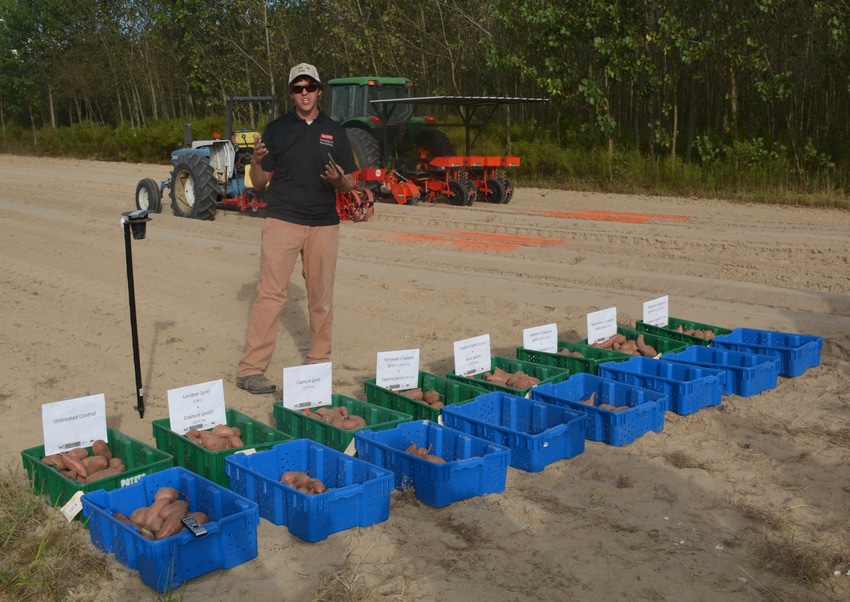
For more than 30 years, sweet potato farmers have turned to chlorpyrifos, or Lorsban, to control wireworms, but with the Aug. 18 decision by the Environmental Protection Agency that essentially bans the use of Lorsban from now on. Growers will need to look for new ways to control the pest.
With this concern in mind, North Carolina State University is conducting research to find alternatives to Lorsban to control wireworms in sweet potatoes.
Speaking at the Sweetpotato Field Day at the Horticultural Crops Research Station in Clinton, N.C., State Extension Entomologist Anders Huseth said his program is looking at an integrated pest management approach to best control the pest.
“In the absence of chlorpyrifos (Lorsban and other formulations), growers will continue to rely on bifenthrin as the key insecticide in both pre-plant incorporated and post-transplant directed application,” Huseth explained.
Work by faculty in the Department of Entomology at North Carolina State over the past decade has shown that bifenthrin can provide adequate protection from wireworms when used as a tandem pre-plant and post-transplant directed application.
Bifenthrin becomes backbone
“In the absence of chlorpyrifos, I expect bifenthrin will become the backbone of our pest management program. We have tested several neonicotinoids and diamide materials as tank-mix components to complement bifenthrin as a pre-plant insecticide program," Huseth said.
“These materials show promise as products that provide additive control to bifenthrin alone. Moreover, many growers have also experimented with neonicotinoids applied through transplant water. The idea is that the transplant water application focuses the active ingredient around the slip instead of distributing the insecticide throughout the transplant bed,” he pointed out.
“Although some have reported success with this strategy, we have not tested it extensively to provide a sound recommendation about the efficacy of this approach or which neonicotinoid is the best fit for this use pattern. In the future, we hope to see registrations for newer experimental insecticides targeting this pest. However, the registration timeline for new products remains unclear at the moment,” he said.
Huseth said his program is monitoring wireworm populations in the eastern North Carolina sweet potato growing area to determine population density and see how integrated pest management and foliar insecticides will work. Together with insecticide screening, their goal is to identify multiple tactics that, in combination, could replace Lorsban.
Wireworms and other soil-borne insect pests (flea beetles, cucumber beetle) are a major concern for sweet potato growers throughout the Southeastern United States. “Although the composition of these pests may vary by region, the damage from the immature stages can cause significant root quality reductions that impact marketability of the sweet potato crop,” Huseth said.
“When infestations are heavy, growers may be forced to cull roots in the field or on the packing line. Light infestations can be diverted from high-value table stock potatoes to processing. However, more stringent requirements of sweet potato processors in recent years has increased the demand for damage-free roots in that market as well. As a result, wireworm damage can result in significant economic losses for sweet potato growers,” he said.
In the research, Huseth and his team are looking at bifenthrin as well as some experimental insecticides that are not registered as well as other registered products. Huseth said the research is designed to improve management strategies by integrating other materials beyond Lorsban.
Tank-mixing products
Huseth is also looking at tank-mixing products. In one test, he paired Verimark with Capture LFR mixed in the tank for pre-plant incorporated applications. Results are preliminary, but Huseth said the Verimark-treated plots look good with a low number of damaged roots in a 20-foot sample.
Huseth is also looking at a tank-mixture of Capture LFR plus Exirel, a diamide that is similar to Verimark, but positioned as a post-transplant product to control wire worms in sweet potatoes. Huseth said so far, this program looks pretty good.
In addition, Huseth is looking at neonicotinoids such as Admire Pro, a formulation of Imidacloprid. “When we position Admire Pro with Capture LFR as a pre-plant incorporated program for wire worm control, the results looked reasonable, but it’s not highly efficacious. We’ve known that about this product for quite some time that it does give us some control, but it might not be as good as some of the other neonicotinoids,” Huseth said.
Additionally, Huseth is examining Majestine, a biological insecticide made by Marrone, paired with bifenthrin. “It looked pretty darn good in the Kinston trial (Cunningham Research Station). It also has some nematicidal activity, so we’re interested whether or not it had some additive benefits for controlling wireworms as well as nematodes” Huseth said
Also, at the Cunningham Research Station, Huseth looked at Platinum, a formulation of thiamethoxam (neonicotinoid) pre-plant insecticide, incorporated with Capture LFR. Huseth said the treatment looked good in the Kinston plot, but may be variable in other situations.
Pulse Check
In essence, Huseth is hoping to get a pulse check on what materials will be effective as Lorsban replacements for sweet potato farmers. Huseth said this is particularly important as farmers face more stringent MRL (maximum residue level) tolerances.
“Unfortunately, for a lot of specialty crops, or fortunately, depending on what side of the fence you are on, we’re going to see a further reduction in a lot of these older chemistries — organophosphates, and some of the pyrethroids — we’re probably going to see those materials be sunsetted in the future,” Huseth explained.
He said it is critical to look at new materials year after year to find alternative control strategies beyond organophosphates. “This is a benefit for food safety as well as marketability abroad. That’s a big part of the equation.”
About the Author(s)
You May Also Like






